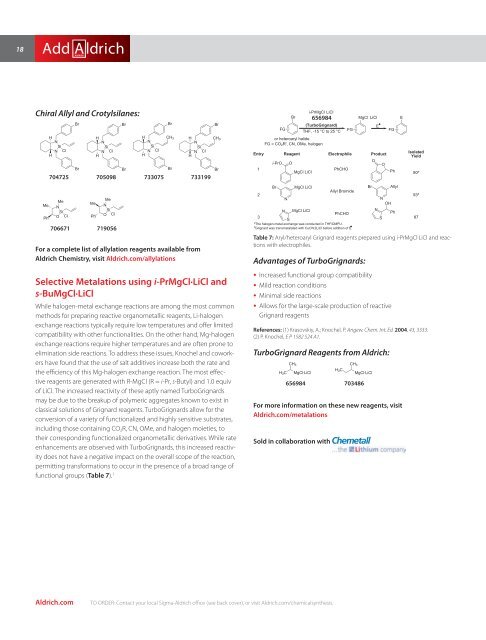Missing out on the latest research developments in ... - Sigma-Aldrich
Missing out on the latest research developments in ... - Sigma-Aldrich
Missing out on the latest research developments in ... - Sigma-Aldrich
Create successful ePaper yourself
Turn your PDF publications into a flip-book with our unique Google optimized e-Paper software.
18<br />
Chiral Allyl and Crotylsilanes:<br />
Me<br />
Ph<br />
H<br />
N<br />
Si<br />
N Cl<br />
H<br />
704725<br />
Me<br />
N<br />
Si<br />
O Cl<br />
706671<br />
For a complete list of allylati<strong>on</strong> reagents available from<br />
<strong>Aldrich</strong> Chemistry, visit <strong>Aldrich</strong>.com/allylati<strong>on</strong>s<br />
Selective Metalati<strong>on</strong>s us<strong>in</strong>g i-PrMgCl·LiCl and<br />
s-BuMgCl·LiCl<br />
While halogen-metal exchange reacti<strong>on</strong>s are am<strong>on</strong>g <strong>the</strong> most comm<strong>on</strong><br />
methods for prepar<strong>in</strong>g reactive organometallic reagents, Li-halogen<br />
exchange reacti<strong>on</strong>s typically require low temperatures and off er limited<br />
compatibility with o<strong>the</strong>r functi<strong>on</strong>alities. On <strong>the</strong> o<strong>the</strong>r hand, Mg-halogen<br />
exchange reacti<strong>on</strong>s require higher temperatures and are often pr<strong>on</strong>e to<br />
elim<strong>in</strong>ati<strong>on</strong> side reacti<strong>on</strong>s. To address <strong>the</strong>se issues, Knochel and coworkers<br />
have found that <strong>the</strong> use of salt additives <strong>in</strong>crease both <strong>the</strong> rate and<br />
<strong>the</strong> effi ciency of this Mg-halogen exchange reacti<strong>on</strong>. The most eff ective<br />
reagents are generated with R-MgCl (R = i-Pr, s-Butyl) and 1.0 equiv<br />
of LiCl. The <strong>in</strong>creased reactivity of <strong>the</strong>se aptly named TurboGrignards<br />
may be due to <strong>the</strong> breakup of polymeric aggregates known to exist <strong>in</strong><br />
classical soluti<strong>on</strong>s of Grignard reagents. TurboGrignards allow for <strong>the</strong><br />
c<strong>on</strong>versi<strong>on</strong> of a variety of functi<strong>on</strong>alized and highly sensitive substrates,<br />
<strong>in</strong>clud<strong>in</strong>g those c<strong>on</strong>ta<strong>in</strong><strong>in</strong>g CO2R, CN, OMe, and halogen moieties, to<br />
<strong>the</strong>ir corresp<strong>on</strong>d<strong>in</strong>g functi<strong>on</strong>alized organometallic derivatives. While rate<br />
enhancements are observed with TurboGrignards, this <strong>in</strong>creased reactivity<br />
does not have a negative impact <strong>on</strong> <strong>the</strong> overall scope of <strong>the</strong> reacti<strong>on</strong>,<br />
permitt<strong>in</strong>g transformati<strong>on</strong>s to occur <strong>in</strong> <strong>the</strong> presence of a broad range of<br />
functi<strong>on</strong>al groups (Table 7). 1<br />
<strong>Aldrich</strong>.com<br />
Br<br />
Br<br />
Me<br />
Ph<br />
H<br />
N<br />
Si<br />
N Cl<br />
H<br />
705098<br />
Me<br />
N<br />
Si<br />
O Cl<br />
719056<br />
Br<br />
Br<br />
H<br />
N<br />
Si<br />
N Cl<br />
H<br />
733075<br />
Br<br />
CH3<br />
Br<br />
H<br />
N<br />
Si<br />
N Cl<br />
H<br />
733199<br />
TO ORDER: C<strong>on</strong>tact your local <strong>Sigma</strong>-<strong>Aldrich</strong> offi ce (see back cover), or visit <strong>Aldrich</strong>.com/chemicalsyn<strong>the</strong>sis.<br />
Br<br />
CH3<br />
Br<br />
Entry<br />
1<br />
2<br />
i-PrMgCl LiCl<br />
Br 656984<br />
(TurboGrignard)<br />
FG<br />
THF, -15 °C to 25 °C<br />
or heteroaryl halide<br />
FG = CO2R', CN, OMe, halogen<br />
FG<br />
MgCl LiCl<br />
Reagent<br />
Electrophile Product<br />
i-PrO O<br />
O<br />
O<br />
MgCl LiCl<br />
PhCHO<br />
Br<br />
N<br />
MgCl LiCl<br />
Allyl Bromide<br />
N MgCl LiCl<br />
PhCHO<br />
3<br />
S<br />
aThe halogen-metal exchange was c<strong>on</strong>ducted <strong>in</strong> THF/DMPU.<br />
bGrignard was transmetalated with CuCN 2LiCl before additi<strong>on</strong> of E.<br />
Br<br />
E<br />
FG<br />
N<br />
OH<br />
N<br />
Ph<br />
S<br />
E<br />
Ph 80 a<br />
Allyl<br />
Isolated<br />
Yield<br />
Table 7: Aryl/heteroaryl Grignard reagents prepared us<strong>in</strong>g i-PrMgCl·LiCl and reacti<strong>on</strong>s<br />
with electrophiles.<br />
Advantages of TurboGrignards:<br />
• Increased functi<strong>on</strong>al group compatibility<br />
• Mild reacti<strong>on</strong> c<strong>on</strong>diti<strong>on</strong>s<br />
• M<strong>in</strong>imal side reacti<strong>on</strong>s<br />
• Allows for <strong>the</strong> large-scale producti<strong>on</strong> of reactive<br />
Grignard reagents<br />
References: (1) Krasovskiy, A.; Knochel, P. Angew. Chem. Int. Ed. 2004, 43, 3333.<br />
(2) P. Knochel, E P 1582 524 A1.<br />
TurboGrignard Reagents from <strong>Aldrich</strong>:<br />
H3C<br />
CH3<br />
MgCl . LiCl<br />
656984<br />
For more <strong>in</strong>formati<strong>on</strong> <strong>on</strong> <strong>the</strong>se new reagents, visit<br />
<strong>Aldrich</strong>.com/metalati<strong>on</strong>s<br />
Sold <strong>in</strong> collaborati<strong>on</strong> with<br />
H3C<br />
CH3<br />
MgCl . LiCl<br />
703486<br />
93 b<br />
87

















